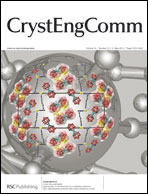A series of 1-(2-amino-2-oxoethyl)-3-carbamoylpyridin-1-ium salts with different anions (Cl−, Br−, BF4−, NO3−, OTf−, PF6− and BPh4−) have been synthesized and characterized by single crystal X-ray diffraction. The results demonstrate that the L-shaped diamide pyridinium cations can aggregate convergently to form a tubular structure or divergently to form a one-dimensional ribbon structure or two-dimensional brick, grid and sheet structures via different hydrogen bonding catemer motifs, including conventional N–H⋯O type (BPh4− (7)), the nonconventional N–H⋯O types (Cl− (1)) and, the mixed N–H⋯O/C–H⋯O type (OTf (5) and PF6− (6)), and the interesting pure C–H⋯O types (Cl− (1), Br− (2) and BF4− (3)).
You have access to this article
 Please wait while we load your content...
Something went wrong. Try again?
Please wait while we load your content...
Something went wrong. Try again?


 Please wait while we load your content...
Please wait while we load your content...